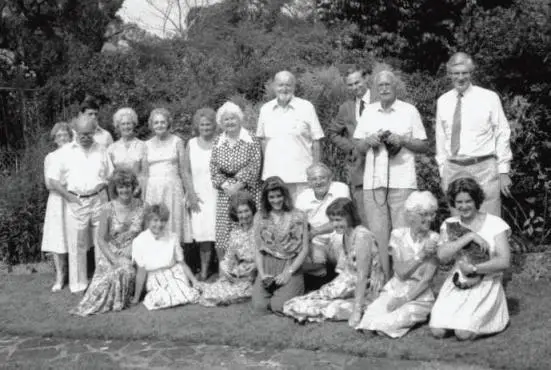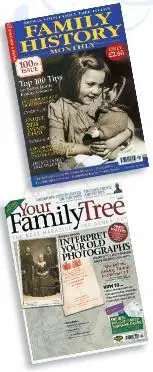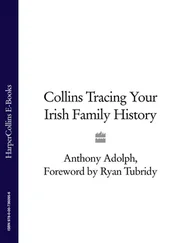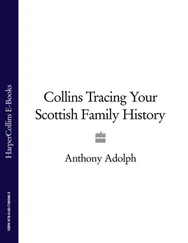Actually, the real prize transcends even that, because sometimes you will find that an ancestor will already have tried to trace the family tree. One of the things that really encouraged me to pursue my own was being given a Harrods’ carrier bag full of ‘the family papers’, which turned out to be my great-great grandmother’s notes, showing her attempts to trace her family tree between 1880 and 1920. Sadly there was no sign of her finished family trees – if there ever were any – and nor have they ever turned up. However, the bag did include replies to letters she had written to her second and third cousins, thus filling out my own family tree before I had ever set foot outside my front door.

Family reunions: a family photograph showing the Adolph, Mitchiner and Gale families celebrating the 80th birthday of my grandfather Joseph Adolph in 1990.

AN OUTLINE OF THE MAIN SOURCES
PRELIMINARY RESEARCH
 Make notes on what you know
Make notes on what you know
 Constantly update your notes
Constantly update your notes
 Ask immediate family
Ask immediate family
 Network with remoter family
Network with remoter family
 Register with www.genesreunited.co.uk ( see here) and other ‘contact’ websites
Register with www.genesreunited.co.uk ( see here) and other ‘contact’ websites
 Update your entries as you learn more
Update your entries as you learn more
 General Registration (from 1837) (see Chapter Five)
General Registration (from 1837) (see Chapter Five)
 Censuses (1841-1901) (see Chapter Six)
Censuses (1841-1901) (see Chapter Six)
 Wills and administrations from 1858 (see Chapter Twelve)
Wills and administrations from 1858 (see Chapter Twelve)
 Unindexed censuses, using directories (see Chapter Eight)
Unindexed censuses, using directories (see Chapter Eight)
 Parish registers (from 1538) (see Chapter Ten)
Parish registers (from 1538) (see Chapter Ten)
 Bishops’ transcripts (from 1598) (see here)
Bishops’ transcripts (from 1598) (see here)
 Manorial records (see Chapter Eleven)
Manorial records (see Chapter Eleven)
 Wills and letters of administration (before 1858) (see Chapter Twelve)
Wills and letters of administration (before 1858) (see Chapter Twelve)
 Gravestones (mainly from 17th century) (see Chapter Thirteen)
Gravestones (mainly from 17th century) (see Chapter Thirteen)
 Newpapers for obituaries, etc. (Mainly from 18th century) (see Chapter Fourteen)
Newpapers for obituaries, etc. (Mainly from 18th century) (see Chapter Fourteen)
 Electoral registers (see Chapter Eighteen), etc. to find addresses
Electoral registers (see Chapter Eighteen), etc. to find addresses
 Parish chest and poor law material (mainly from 17th century) (see Chapter Nineteen)
Parish chest and poor law material (mainly from 17th century) (see Chapter Nineteen)
 Occupation records (especially army and navy, mainly from 18th century) (see Chapter Twenty-Oneand Chapter Twenty-Two)
Occupation records (especially army and navy, mainly from 18th century) (see Chapter Twenty-Oneand Chapter Twenty-Two)
 Legal records (see Chapter Twenty-Five)
Legal records (see Chapter Twenty-Five)
 Education records (see Chapter Twenty-Six)
Education records (see Chapter Twenty-Six)
 Printed pedigrees, heraldic records, etc. (see Chapter Thirty-Oneand Chapter Thirty-Two)
Printed pedigrees, heraldic records, etc. (see Chapter Thirty-Oneand Chapter Thirty-Two)
AND, IF ALL GOES EXCEPTIONALLY WELL …
 Medieval tax lists and land records (from 1086) (see Chapter Twenty-Three)
Medieval tax lists and land records (from 1086) (see Chapter Twenty-Three)
 Early university and school records from Middle Ages (see Chapter Twenty-Six)
Early university and school records from Middle Ages (see Chapter Twenty-Six)
 Ancient oral pedigrees now in print
Ancient oral pedigrees now in print

CHAPTER TWO WRITING IT ALL DOWN
The rest of this book is about how to trace your ancestry, but this chapter focuses on how to record your findings, from getting all your notes written down on computer or paper and moving onto understanding the family tree conventions.

Your Family Tree and Family History Monthly genealogical magazines.
Some people can get bogged down in choosing computer packages, filing systems and so on. Frankly, if you enjoy computer programs, then you’ll love family history, as there is a vast array to chose from, reviewed and advertised in the genealogical magazines like Your Family Tree and Family History Monthly , with an excellent comparative chart at www.Myhistory.co.uk. Everyone has a preference. Personally, I don’t rate very highly the packages that invite you to fill in forms about all your ancestors. I feel it de-humanises them and encourages some people to become obsessed simply with the act of form filling with completing forms that can’t be. Me? I keep a cardboard file for each family I am tracing, containing photographs, documents, notes and so on, and a rough family tree on paper, and then maintain a narrative pedigree on my word processor. Once I feel satisfied with what I have done, I may also write up a summarised version of the family story, including the best pictures and documents, either to circulate among the family or to submit to a relevant family history journal ( see here).
Читать дальше



 Make notes on what you know
Make notes on what you know











